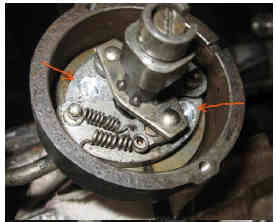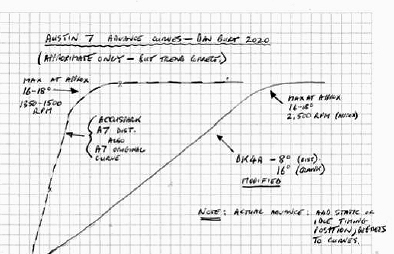

Timing is Everything!
By Dan Burt (BA7C)
I have long suspected that the Austin 7 ignition timing was wrong using modern fuels. Static timed with an advance of about 8 degrees using a DK4A 8 deg distributor means the engine will run OK at idle (400 rpm). At 50 mph (3,300 rpm) the car ran fine, but once the revs dropped to 800 she would knock, lose power, overheat and was clearly too advanced. When you look at the advance curve this is not surprising, because the advance maxes out at about 1400 rpm. I had tried an ACCUSPARK Austin 7 distributor, timed to the original Austin specs, but this was worse.
The 'Octane' label was developed in 1929 to enable fuels
to be rated according to their knock values. This was especially important for
aircraft use and efficiency. It seems that automotive fuels were between 40 to
60 octane in the early 1930s, and the Austin was set up for this.
Now, with 91 octane standard petrol (since the 1960s) of course the timing of
the Austin 7 is entirely wrong. The DK4A gives a maximum advance of 16 deg
(crank) at around 1400 rpm. Which is why the engine was way too advanced at this
rpm.
The firing point is determined by the speed of the flame front of the ignited fuel/ air mixture, and we want maximum expansion of the burn to happen at about TDC. Otherwise, the burn tries to push the piston back down the bore, resulting in the knocking and vibration. The more revs, the earlier we have to fire the ignition to get this result, hence the progressive advance as the speed increases. Given the much higher octane rating of 'modern' fuels, we need to extend that advance over the whole range of engine speeds, and that is what I have done.
The 16 deg potential advance of the DK4A plus the idle timing now gives about 25 degrees advance at 3,300 rpm instead of halfway up the range at 1400 rpm, when the car is likely to be pulling quite hard. I suspect that most crank and rear main damage has been caused by excessive knocking and vibration fatigue over time, something which, with a new engine, is hardly heard.
What I have done: I have replaced the centrifugal weight springs with two the same size but of the lighter type! The springs are easily snapped, but I managed to get them to just retain the weights at idle by bending them carefully. Check all pivots too, and all pivot positions. In situ, I guessed/ calculated that a 5/16" inch hole drilled in the tip of each weight would give me a broader range of advance of the 16 degrees available. I would suggest that a ¼" hole - drilled to the bottom only - may suit unmodified vehicles.
I now have heaps of power and the car is a different car to drive, smooth throughout the range with little vibrations. Please see below for the pics and a graph.

